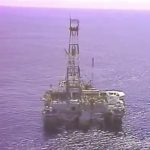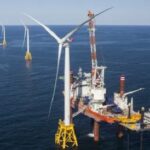Oil Company con game exposed; the old switcheroo by Jim Lovgren
 As the human population continues to increase in abundance, the need for natural resources to sustain our existence also increases. This places a demand on our environment to supply food, through Agriculture, Aquaculture, hunting and fishing, but also to supply natural resources such as fossil fuels, and minerals to support an increasingly urban population. For more than a century, fossil fuels have led humanity to unthinkable advances in transportation, electrical production, food production, virtually all of the advancements of the last century and a half have the use of fossil fuels to thank. The downside of this usage has been air pollution, destruction of all types of habitats by exploration, mining, and drilling. Over the last fifty years, as our easy to find land based natural resources have been depleted, man has looked at the resources that are not easily discovered or recovered, those on and under the ocean floor, including fossil fuels and minerals.
As the human population continues to increase in abundance, the need for natural resources to sustain our existence also increases. This places a demand on our environment to supply food, through Agriculture, Aquaculture, hunting and fishing, but also to supply natural resources such as fossil fuels, and minerals to support an increasingly urban population. For more than a century, fossil fuels have led humanity to unthinkable advances in transportation, electrical production, food production, virtually all of the advancements of the last century and a half have the use of fossil fuels to thank. The downside of this usage has been air pollution, destruction of all types of habitats by exploration, mining, and drilling. Over the last fifty years, as our easy to find land based natural resources have been depleted, man has looked at the resources that are not easily discovered or recovered, those on and under the ocean floor, including fossil fuels and minerals.
Oil companies developed techniques to not only locate oil and gas reserves thousands of feet below the ocean bottom, but to drill and recover them. Unfortunately, the tools used to locate oil reserves under the ocean floor, primarily seismic air gun arrays, have left a trail of dead sea creatures in its wake. Just like the US Navy, who for years denied the growing body of evidence linking military sonar usage to localized marine mammal strandings, the oil industry has denied any link of seismic research to the marine mammal strandings that invariably occur near their operations. To their credit, newer seismic and sonar equipment has been created that is less intrusive, [to a degree] to the marine environment. Seismic air gun arrays typically operate in the 240-245 DBs sound level, while newer sub-bottom profilers typically operate in the 200 to 210 DBs range, but can reach over 230 DBs depending on the power level used. Underwater sound over 180 DBs is recognized as being harmful to marine
mammals, and can cause TTS, Temporary Threshold Shift, or at louder levels PTS, Permanent Threshold Shift, which results in death. When the US government, through NOAA or the Department of the Interior issue Incidental take permits, they are classified as level B, which can cause TTS, or Level A which can cause PTS.
The exploration and drilling for oil and mineral deposits in the ocean has crept into depths of water unimaginable only a few decades ago, causing unknown effects upon the marine environment and the creatures that inhabit it. Because these effects are not visible, being under vast amounts of surface water, it is hard to know if harm is being done by these efforts, unless a situation such as the BP gulf oil spill takes place, and oil rises to the surface. Just as the Exxon Valdez disaster two decades
before, awakened the public to the hazards of oil tankers with single hull designs, prone to puncture, the BP disaster spotlighted what happens when a deep water well has a catastrophic failure. With increasing public awareness of “climate change”, which was “Global Warming” before that, and even the coming “Ice age” only 40 years ago, fingers pointed to fossil fuels as the cause of these effects. This has led to an increased development and usage of “green Energy”, primarily Solar, and Wind, while painting fossil fuels as the villain of all that is wrong in the world. This is poetic justice as it was the oil companies that created Oceana over two decades ago to villainize the commercial fishing industry to cover up their own sins.
 A few decades ago, the huge American tobacco companies faced a serious problem as lawsuits and an awakened population fought to limit or ban altogether the use of tobacco products due to their now known deleterious health effects. This forced the companies to diversify into other business areas, or go bankrupt. We see the same thing happening now with our fossil fuel producers, they can see the writing on the wall as public opinion has shifted against them due to fears of climate change. While US based oil companies have been slow to invest in renewable technology, European companies have not. Orsted, a multinational power company based in Denmark, has purchased the most wind lease areas on the US east coast. TotalEnergies is a French oil/power company, while Shell is Dutch, and Blackstone is Canadian. Interestingly these companies last year broke records in the amount of money paid for 5 leases in the New York bight last year, with bids reaching over 4 billion dollars, an average price of 800 million each. The unexpected bidding took everybody by surprise, as BOEM expected the sales to fetch around one billion total. Two months after that auction, two more lease areas were sold off of the North Carolina coast, one to TotalEnergies for 160 million, and the other to Duke Energy Renewables for 155million. This was followed by a December sale for six sites off of the California coast, that reaped 757 million total with winning bids ranging from 130 million, to 173.8 million.
A few decades ago, the huge American tobacco companies faced a serious problem as lawsuits and an awakened population fought to limit or ban altogether the use of tobacco products due to their now known deleterious health effects. This forced the companies to diversify into other business areas, or go bankrupt. We see the same thing happening now with our fossil fuel producers, they can see the writing on the wall as public opinion has shifted against them due to fears of climate change. While US based oil companies have been slow to invest in renewable technology, European companies have not. Orsted, a multinational power company based in Denmark, has purchased the most wind lease areas on the US east coast. TotalEnergies is a French oil/power company, while Shell is Dutch, and Blackstone is Canadian. Interestingly these companies last year broke records in the amount of money paid for 5 leases in the New York bight last year, with bids reaching over 4 billion dollars, an average price of 800 million each. The unexpected bidding took everybody by surprise, as BOEM expected the sales to fetch around one billion total. Two months after that auction, two more lease areas were sold off of the North Carolina coast, one to TotalEnergies for 160 million, and the other to Duke Energy Renewables for 155million. This was followed by a December sale for six sites off of the California coast, that reaped 757 million total with winning bids ranging from 130 million, to 173.8 million.
To put this in perspective, in 2015 two companies bid less than 2 million dollars for 343,833 acres off of New Jersey. In 2018 three companies bid 405 million total for 390,000 acres off of Massachusetts. It appears that the wind lease sites in general have increased in desirability in the last 8 years, and that the price is being inflated by the entrance of deep pocketed oil companies in to the renewable market. But that doesn’t explain the recent disparity between the last years sales in the New York bight, and those later sales off of North Carolina, and California. Is close proximity to the New York metropolitan area worth that much more than sites off of our most populous state, California? Perhaps there is a different reason for those bank-breaking sales in the New York bight. In the late 1970’s and early 1980’s the oil companies did some seismic testing and experimental well drilling off the US east coast, including on the Georges bank. Most of the wells came up dry, and oil and gas reserves
discovered were considered not economically feasible to produce. There were a number of wells though, that indicated large natural gas reserves, these were all situated in the New York bight, precisely where those outrageously priced lease sales are. The winning bidders were Shell/EDF Renewables, winning two leases, Blackstone, Totalenergies, and Orsted, won the others. Is it a coincidence that oil companies paid what amounts to four times more then the average wind energy lease site sold for? The Marcellus shale deposits extend into the Mid-Atlantic outer continental shelf, and this is what was discovered 40 years ago with those experimental wells.
The 1980’s saw the east coast public up in arms about pollution caused by sludge and contaminated dredge spoils dumping, and Congress pushed through a ban on oil drilling along the whole east coast. Since that time the oil companies have been scheming about how to get back the east coast so they can get those reserves. Over the decades since, advances in drilling technology and the use of fracking have made previously unprofitable oil and gas reserves now profitable and also areas that were
inaccessible, are now accessible. The east coast drilling ban was partially lifted and plans were made to have an 8-year geographic survey of the whole east coast continental shelf in 2012. The newly renamed Bureau of Ocean Energy was in charge of this effort. They had been named the Mineral Management Service, but an investigation into its operations had disclosed widespread corruption involving bribes, sex with oil company executives, and cocaine parties. The government did what any government would do under the circumstances, they slapped a couple of wrists, and just changed their name, but not the people or mindset within the agency. If you think what is happening now to the marine mammals off our coast, where BOEM/NOAA has issued over 100,000 level B takes, and 332 level A takes, you should
see what was proposed in 2012, all predicated on the use of seismic air gun arrays. Over an 8 year period level A takes allowed would be 138,612 marine mammals, and level B takes would have amounted to 13,586,251. Included in the level A takes would be up to two Northern Right Whales a year, up to ten over the eight-year period. Fortunately, this proposal was defeated before it could start, thanks to the organizing work of Clean Ocean Action, and also the now absent, NRDC, Environmental
Defense Fund, Conservation law Foundation, and many more who opposed seismic testing for oil exploration. With not only increasing energy demands, but also the need for rare earth minerals, the energy industry has been desperately seeking to map our offshore energy and mineral deposits for exploitation but have met too much opposition from environmentalists opposed to oil drilling.
 Along comes Biden’s green new deal, and the east coast is now swamped with offshore research vessels using both sonar and seismic devises to map the sea floor and thousands of feet underneath it, for wind development. The same vessels in many cases that would have been involved with the 2012 proposed marine mammal massacre in search of oil reserves. These vessels are not only surveying the area in the lease site, but for many miles away from them, in many cases overlapping into other lease sites, or just mapping bottom that will never be available. Why? It can’t be just to kill everything on the ocean bottom, or could it? In the last century the European countries massacred over 100 million of their own people in wars, so they obviously don’t have much regard for human life, let alone a few Dolphins and Whales. They lie that their offshore wind farms have not caused any marine mammal deaths, yet the UK has seen a doubling of marine mammal strandings since the year 2000, when they started building offshore wind factories. The mad rush to map the east coast as quickly as possible with as many vessels as they could procure is because they know their time is limited. It’s limited by how long it takes the American public to realize that they have been victimized by the old “switcheroo”. The oil
Along comes Biden’s green new deal, and the east coast is now swamped with offshore research vessels using both sonar and seismic devises to map the sea floor and thousands of feet underneath it, for wind development. The same vessels in many cases that would have been involved with the 2012 proposed marine mammal massacre in search of oil reserves. These vessels are not only surveying the area in the lease site, but for many miles away from them, in many cases overlapping into other lease sites, or just mapping bottom that will never be available. Why? It can’t be just to kill everything on the ocean bottom, or could it? In the last century the European countries massacred over 100 million of their own people in wars, so they obviously don’t have much regard for human life, let alone a few Dolphins and Whales. They lie that their offshore wind farms have not caused any marine mammal deaths, yet the UK has seen a doubling of marine mammal strandings since the year 2000, when they started building offshore wind factories. The mad rush to map the east coast as quickly as possible with as many vessels as they could procure is because they know their time is limited. It’s limited by how long it takes the American public to realize that they have been victimized by the old “switcheroo”. The oil
companies could not get seismic mapping of the east coast approved because of public opposition to oil drilling, so they are using another tactic, using climate fear mongering and the dream of a carbon free future thanks to the miracle of wind turbines. The oil companies have won this war, the marine environment has lost. As wind developers are increasingly delaying, or even cancelling projects due to escalating costs, and increasing public opposition, the oil companies will now, thanks to the intense bottom surveying, know where and how much oil and gas reserves are off the east coast. Mineral deposits are bound to be discovered, and the pressure will be brought to mine them. The industrialization of the Atlantic seaboard has just begun, aided by the so called environmental groups that had previously been opposed to such operations. Its amazing how a few dollars have the ability to influence an NGO’s integrity.
The Inflation Reduction Act places new restrictions on the Department of the Interior’s authority to issue offshore wind leases. For ten years after the enactment of the IRA, BOEM will be prohibited from issuing an offshore wind lease area under 43 U.S.C. 1337[p][1][c[, unless BOEM has offered at least 60 million acres on the outer continental shelf for oil and gas leasing, and also executed an oil and gas lease in that offshore lease sale in the previous year. BOEM has proven that it is still in the deep pockets of the oil industry, they’re just a little better at hiding it.






Leave a Reply